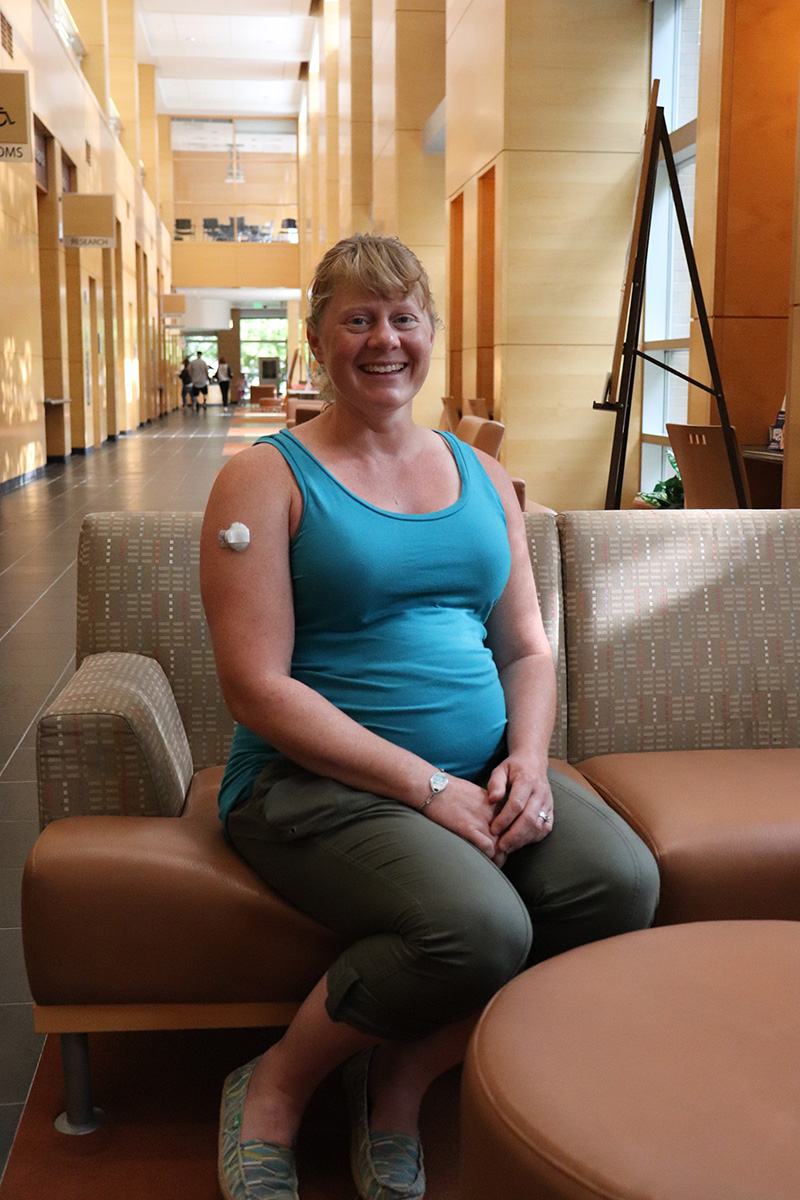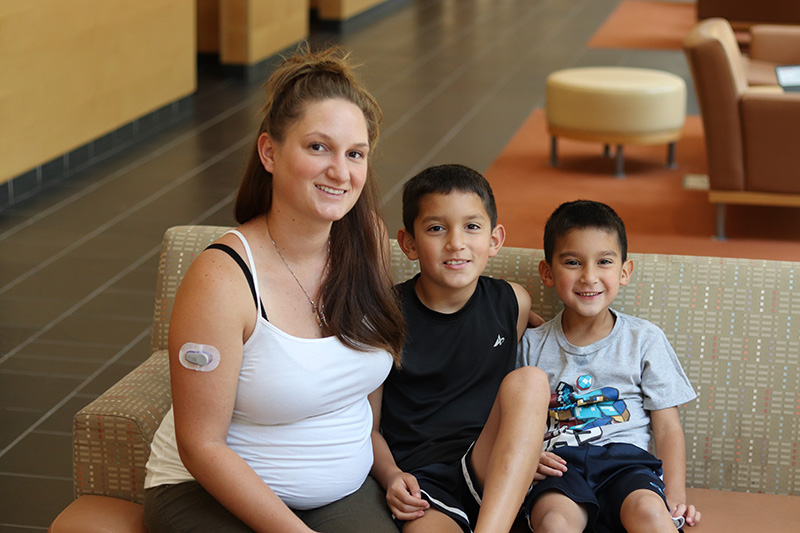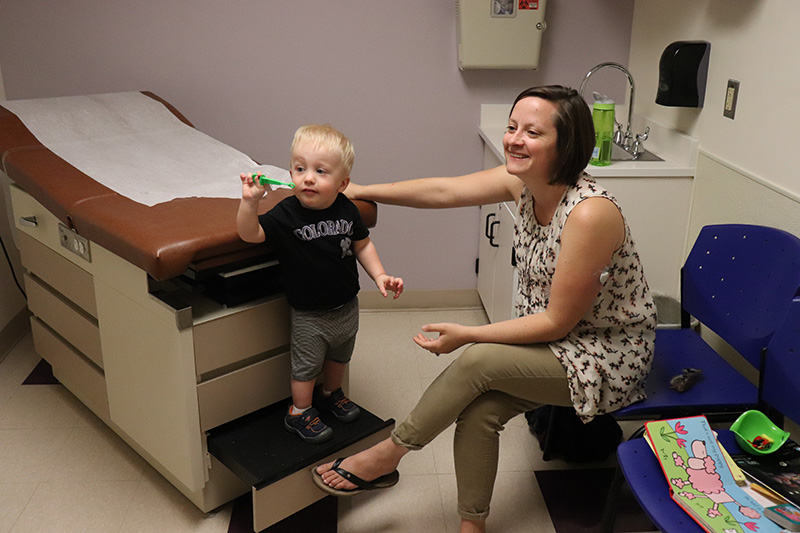By Sarit Polsky, MD, MPH and Rachel Garcetti, PA-C, MS
Pregnancy and Women’s Health Clinic, Barbara Davis Center for Diabetes
-
-
 Blood sugar goals in pregnancy resemble normal or near-normal levels:
Blood sugar goals in pregnancy resemble normal or near-normal levels:
- A1c <6% for most of the pregnancy
- Fasting glucose of 70-95
- Post-meal glucose <130-140 at 1 hour and <120 at 2 hours
- Insulin requirements change dramatically as the pregnancy progresses:
- Usually insulin doses go down in the first trimester (insulin-sensitive phase)
- Insulin doses go up by double or triple in the 2nd and 3rd trimesters (insulin-resistant phase)
- Insulin needs decrease the most significantly after delivering the baby (to pre-pregnancy doses or less)
- Breastfeeding can reduce insulin doses further
- Low blood sugar risk increases dramatically in the first trimester because of increased insulin-sensitivity. Pregnant women often lose their body’s warning signs of low blood sugar, such as shaking, sweating, hunger, irritability, fatigue, etc. If low blood sugars are not caught and treated quickly, mom and baby may be in immediate danger.
- Women with poorly controlled blood sugars at conception and in the first trimester have a higher risk of having babies with congenital malformations, while the risk of malformations in women with good glucose control approaches that of women without diabetes
- Risk of malformations can be as high as 25% when A1c is > 10% at conception/early pregnancy
- Women with T1D should use some form of contraception until A1c is at least < 7.0% and ideally < 6.5%
- Children of women with T1D are at higher risk for developing T1D
- Risk of developing T1D is about 3% when just the mother has T1D
- Risk of developing T1D is about 6% when just the father has T1D
- Risk of developing T1D is as high as 10-20% when both parents have T1D
- Children of mothers with T1D can be screened for autoantibodies associated with the development of T1D after their first birthday through the TrialNet Pathway to Prevention Study at the Barbara Davis Center
 Diabetes technologies can be helpful in managing pregnancies with T1D:
Diabetes technologies can be helpful in managing pregnancies with T1D:
- Insulin pumps can provide more precise insulin dosing (fractions of a unit of insulin), take into account active insulin in the body, record carbohydrate loads and insulin doses, and can temporarily reduce or lower insulin delivery in the event of low or impending low glucose
- Continuous glucose monitors (CGMs) allow women to identify trends in glucose levels and, with some monitors, to get alerts in real-time when their levels are too high or too low
- Insulin pumps and CGMs can be downloaded from home and the data shared with a diabetes expert who is still in his/her office to help determine insulin adjustments
- There are glucose meters and smartphone apps that have calculators to help women on insulin injections figure out how much insulin to give to correct high glucose or for a carbohydrate load
- Some of these technologies are not approved by the FDA for use in pregnancy, so they are used “off-label.” Their use in pregnancy should be discussed with the diabetes experts women work with during pregnancy
- Use of a CGM throughout pregnancy can reduce the risk of complications in the babies of pregnant women with T1D:
- Research shows that women who used a CGM during pregnancy had fewer large babies (>90th percentile), babies requiring intravenous dextrose (glucose) for low sugars, and babies requiring admission to the neonatal intensive care unit
- These effects are most consistent in women who use the CGM all the time, rather than intermittently
- The pregnancy can place a heavier emotional burden on women:
- There is stress from the daily goals of diabetes care
- Some women develop a fear or a worsening fear of low blood sugars
- Extra medical visits and health care costs can be worrisome
- Pregnancies associated with type 1 diabetes (T1D) need a team of medical experts to be successful. The number of medical visits goes up drastically in pregnancy:
- Regular visits with the diabetes care team every 1 to 4 weeks throughout pregnancy
- Visits with an eye expert for diabetes eye exams at least once each trimester and a month post-partum
- Obstetric visits every 2 to 4 weeks in the 1st and 2nd trimesters, and every week in the 3rd trimester
- Ultrasound visits every month starting around 18-20 weeks of pregnancy
- Fetal non-stress testing 1-2 times per week starting at 32 weeks of pregnancy

- Blood sugars throughout pregnancy can have lasting effects on the baby that persist into childhood and adulthood:
- Infants exposed to maternal hyperglycemia in-utero are more likely to be born large-for-gestational age (LGA)
- Infants whose weight is > the 90th percentile for gestational age are classified as LGA
- LGA infants have a higher risk of developing childhood obesity, hypertension, metabolic syndrome, and type 2 diabetes as adults
- Optimal glucose control in pregnant women with T1D decreases the likelihood of metabolic problems for their infants in the future
- More studies are needed to help pregnant women with T1D:
- Pregnant women are considered a vulnerable population. This sometimes makes it more difficult to get research studies approved
 Pregnancy studies can be very expensive because pregnancy takes a long time (40 weeks) and many clinical centers don’t have enough pregnant women with T1D so they have to partner with other centers to do research
Pregnancy studies can be very expensive because pregnancy takes a long time (40 weeks) and many clinical centers don’t have enough pregnant women with T1D so they have to partner with other centers to do research- More studies are needed to help guide decisions about how best to manage insulin, reduce emotional burdens, reduce complications, and improve health outcomes in pregnancy
- The Helping Little Hands Program, sponsored by the Children’s Diabetes Foundation, provides financial support for pregnant women with type 1 diabetes (T1D) to ensure they have the proper technology, supplies, and associated appointment funds to ensure a healthy pregnancy and baby. The program serves at-risk pregnant women who do not have access to Continuous Glucose Monitoring (CGM) systems and other related resources to improve their diabetes care. Click here to learn more.
-





